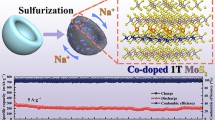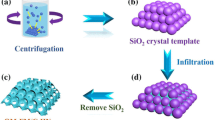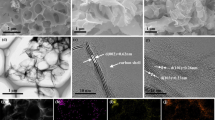Abstract
Weak ion diffusion and electron transport due to limited interlayer spacing and poor electrical conductivity have been identified as critical roadbacks for fast and abundant energy storage of both MoS2-based lithium ion batteries (LIBs) and sodium ion batteries (SIBs). In this work, MoS2 porous-hollow nanorods (MoS2/m-C800) have been designed and synthesized via an annealing-followed chemistry-intercalated strategy to solve the two issues. They are uniformly assembled from ultrathin MoS2 nanosheets, deviated to the rod-axis direction, with expanded interlayer spacing due to alternate intercalation of N-doped carbon monolayers between the adjacent MoS2 monolayers. Electrochemical studies of the MoS2/m-C800 sample, as an anode of LIBs, demonstrate that the superstructure can deliver a reversible discharge capacity of 1,170 mAh•g−1 after 100 cycles at 0.2 A•g−1 and maintain a reversible capacity of 951 mAh•g−1 at 1.25 A•g−1 after 350 cycles. While for SIBs, the superstructure also delivers a reversible discharge capacity of 350 mAh•g−1 at 0.5 A•g−1 after 500 cycles and exhibits superior rate capacity of 238 mAh•g−1 at 15 A•g−1.The excellent electrochemical performance is closely related with the hierarchical superstructures, including expanded interlayer spacing, alternate intercalation of carbon monolayers and mesoporous feature, which effectively reduce ion diffusion barrier, shorten ion diffusion paths and improve electrical conductivity.

Similar content being viewed by others
References
Tarascon, J. M.; Armand, M. Issues and challenges facing rechargeable lithium batteries. Nature 2001, 414, 359–367.
Palacin, M. R. Recent advances in rechargeable battery materials: A chemist’s perspective. Chem. Soc. Rev. 2009, 38, 2565–2575.
Armand, M.; Tarascon, J. M. Building better batteries. Nature 2008, 451, 652–657.
Yin, H.; Li, Q. W.; Cao, M. L.; Zhang, W.; Zhao, H.; Li, C.; Huo, K. F.; Zhu, M. Q. Nanosized-bismuth-embedded 1D carbon nanofibers as high-performance anodes for lithium-ion and sodium-ion batteries. Nano Res. 2017, 10, 2156–2167.
Yin, H.; Cao, M. L.; Yu, X. X.; Zhao, H.; Shen, Y.; Li, C.; Zhu, M. Q. Self-standing Bi2O3 nanoparticles/carbon nanofiber hybrid films as a binder-free anode for flexible sodium-ion batteries. Mater. Chem. Front. 2017, 1, 1615–1621.
David, L.; Bhandavat, R.; Singh, G. MoS2/graphene composite paper for sodium-ion battery electrodes. ACS Nano 2014, 8, 1759–1770.
Cheng, X. B.; Zhang, R.; Zhao, C. Z.; Zhang, Q. Toward safe lithium metal anode in rechargeable batteries: A review. Chem. Rev. 2017, 117, 10403–10473.
Wang, Y. X.; Liu, B.; Li, Q. Y.; Cartmell, S.; Ferrara, S.; Deng, Z. D.; Xiao, J. Lithium and lithium ion batteries for applications in microelectronic devices: A review. J. Power Sources 2015, 286, 330–345.
Yin, H.; Yu, X. X.; Li, Q. W.; Cao, M. L.; Zhang, W.; Zhao, H.; Zhu, M. Q. Hollow porous CuO/C composite microcubes derived from metal-organic framework templates for highly reversible lithium-ion batteries. J. Alloys Compd. 2017, 706, 97–102.
Yin, H.; Yu, X. X.; Yu, Y. W.; Cao, M. L.; Zhao, H.; Li, C.; Zhu, M. Q. Tellurium nanotubes grown on carbon fiber cloth as cathode for flexible all-solid-state lithium-tellurium batteries. Electrochim. Acta 2018, 282, 870–876.
Stephenson, T.; Li, Z.; Olsen, B.; Mitlin, D. Lithium ion battery applications of molybdenum disulfide (MoS2) nanocomposites. Energy Environ. Sci. 2014, 7, 209–231.
Yu, X. Y.; Hu, H.; Wang, Y. W.; Chen, H. Y.; Lou, X. W. Ultrathin MoS2 nanosheets supported on N-doped carbon nanoboxes with enhanced lithium storage and electrocatalytic properties. Angew. Chem., Int. Ed. 2015, 54, 7395–7398.
Hu, X. L.; Zhang, W.; Liu, X. X.; Mei, Y. N.; Huang, Y. H. Nanostructured Mo-based electrode materials for electrochemical energy storage. Chem. Soc. Rev. 2015, 44, 2376–2404.
Sun, W. Y.; Li, P.; Liu, X.; Shi, J. J.; Sun, H. M.; Tao, Z. L.; Li, F. J.; Chen, J. Size-controlled MoS2 nanodots supported on reduced graphene oxide for hydrogen evolution reaction and sodium-ion batteries. Nano Res. 2017, 10, 2210–2222.
Zhu, Z. Q.; Tang, Y. X.; Leow, W. R.; Xia, H. R.; Lv, Z. S.; Wei, J. Q.; Ge, X.; Cao, S. K.; Zhang, Y. Y.; Zhang, W. et al. Approaching the lithiation limit of MoS2 while maintaining its layered crystalline structure to improve lithium storage. Angew. Chem., Int. Ed. 2019, 58, 3521–3526.
Jiao, Y. C.; Mukhopadhyay, A.; Ma, Y.; Yang, L.; Hafez, A. M.; Zhu, H. L. Ion transport nanotube assembled with vertically aligned metallic MoS2 for high rate lithium-ion batteries. Adv. Energy Mater. 2018, 8, 1702779.
Shi, L.; Zhao, T. S. Recent advances in inorganic 2D materials and their applications in lithium and sodium batteries. J. Mater. Chem. A 2017, 5, 3735–3758.
Xu, X. D.; Liu, W.; Kim, Y.; Cho, H. Nanostructured transition metal sulfides for lithium ion batteries: Progress and challenges. Nano Today 2014, 9, 604–630.
Zhang, S. P.; Chowdari, B. V. R.; Wen, Z. Y.; Jin, J.; Yang, J. H. Constructing highly oriented configuration by few-layer MoS2: Toward high-performance lithium-ion batteries and hydrogen evolution reactions. ACS Nano 2015, 9, 12464–12472.
Zhang, P.; Qin, F. R.; Zou, L.; Wang, M. R.; Zhang, K.; Lai, Y. Q.; Li, J. Few-layered MoS2/C with expanding d-spacing as a high-performance anode for sodium-ion batteries. Nanoscale 2017, 9, 12189–12195.
Chang, K.; Chen, W. X. L-Cysteine-assisted synthesis of layered MoS2/graphene composites with excellent electrochemical performances for lithium ion batteries. ACS Nano 2011, 5, 4720–4728.
Wang, X. X.; Tian, J. H.; Cheng, X.; Na, R.; Wang, D. D.; Shan, Z. Q. Chitosan-induced synthesis of hierarchical flower ridge-like MoS2/N-doped carbon composites with enhanced lithium storage. ACS Appl. Mater. Interfaces 2018, 10, 35953–35962.
Liu, Y. T.; Zhu, X. D.; Duan, Z. Q.; Xie, X. M. Flexible and robust MoS2-graphene hybrid paper cross-linked by a polymer ligand: A high-performance anode material for thin film lithium-ion batteries. Chem. Commun. 2013, 49, 10305–10307.
Zhu, H. L.; Zhang, F.; Li, J. R.; Tang, Y. B. Penne-like MoS2/carbon nanocomposite as anode for sodium-ion-based dual-ion battery. Small 2018, 14, 1703951.
Jiang, H.; Ren, D. Y.; Wang, H. F.; Hu, Y. J.; Guo, S. J.; Yuan, H. Y.; Hu, P. J.; Zhang, L.; Li, C. Z. 2D monolayer MoS2-carbon interoverlapped superstructure: Engineering ideal atomic interface for lithium ion storage. Adv. Mater. 2015, 27, 3687–3695.
Shi, Z. T.; Kang, W.; Xu, J.; Sun, Y. W.; Jiang, M.; Ng, T. W.; Xue, H. T.; Yu, D. Y. W.; Zhang W. J.; Lee, C. S. Hierarchical nanotubes assembled from MoS2-carbon monolayer sandwiched superstructure nanosheets for high-performance sodium ion batteries. Nano Energy 2016, 22, 27–37.
Jing, L. Y.; Lian, G.; Niu, F. E.; Yang, J.; Wang, Q. L.; Cui, D. L.; Wong, C. P.; Liu, X. Z. Few-atomic-layered hollow nanospheres constructed from alternate intercalation of carbon and MoS2 monolayers for sodium and lithium storage. Nano Energy 2018, 51, 546–555.
Wang, R. T.; Wang, S. J.; Jin, D. D.; Zhang, Y. B.; Cai, Y. J.; Ma, J. M.; Zhang, L. Engineering layer structure of MoS2-graphene composites with robust and fast lithium storage for high-performance Li-ion capacitors. Energy Storage Mater. 2017, 9, 195–205.
Liang, Y. L.; Yoo, H. D.; Li, Y. F.; Shuai, J.; Calderon, H. A.; Hernandez, F. C. R.; Grabow L. C.; Yao, Y. Interlayer-expanded molybdenum disulfide nanocomposites for electrochemical magnesium storage. Nano Lett. 2015, 15, 2194–2202.
Zhang, X.; Lian, G.; Si, H. B.; Wang, J.; Cui, D. L.; Wang, Q. L. Novel BN porous-hollow nanorods: Synthesis, tunable dimensions, property and formation mechanism. J. Mater. Chem. A 2013, 1, 11992–11998.
Xu, J.; Zhang, J. J.; Zhang, W. J.; Lee, C. S. Interlayer nanoarchitectonics of two-dimensional transition-metal dichalcogenides nanosheets for energy storage and conversion applications. Adv. Energy Mater. 2017, 7, 1700571.
Ren, D. Y.; Hu, Y. J.; Jiang, H. B.; Deng, Z. N.; Petr, S.; Jiang, H.; Li, C. Z. Salt-templating protocol to realize few-layered ultrasmall MoS2 nanosheets inlayed into carbon frameworks for superior lithium-ion batteries. ACS Sustainable Chem. Eng. 2016, 4, 1148–1153.
Sun, D.; Ye, D. L.; Liu, P.; Tang, Y. G.; Guo, J.; Wang, L. Z.; Wang, H. Y. MoS2/graphene nanosheets from commercial bulky MoS2 and graphite as anode materials for high rate sodium-ion batteries. Adv. Energy Mater. 2018, 8, 1702383.
Yang, C.; Chen, Z. X.; Shakir, I.; Xu, Y. X.; Lu, H. B. Rational synthesis of carbon shell coated polyaniline/MoS2 monolayer composites for high¬performance supercapacitors. Nano Res. 2016, 9, 951–962.
Yin, H.; Liu, Y.; Yu, N.; Qu, H. Q.; Liu, Z. T.; Jiang, R. Z.; Li, C.; Zhu, M. Q. Graphene-like MoS2 nanosheets on carbon fabrics as high-performance binder-free electrodes for supercapacitors and Li-ion batteries. ACS Omega 2018, 3, 17466–17473.
Fan, X. B.; Xu, P. T.; Zhou, D. K.; Sun, Y. F.; Li, Y. C.; Nguyen, M. A. T.; Terrones, M.; Mallouk, T. E. Fast and efficient preparation of exfoliated 2H MoS2 nanosheets by sonication-assisted lithium intercalation and infrared laser-induced 1T to 2H phase reversion. Nano Lett. 2015, 15, 5956–5960.
Khan, M.; Yousaf, A. B.; Chen, M. M.; Wei, C. S.; Wu, X. B.; Huang, N. B.; Qi, Z. M.; Li, L. B. Molybdenum sulfide/graphene-carbon nanotube nanocomposite material for electrocatalytic applications in hydrogen evolution reactions. Nano Res. 2016, 9, 837–848.
Lai, L. F.; Huang, G. M.; Wang X. F.; Weng, J. Solvothermal syntheses of hollow carbon microspheres modified with -NH2 and -OH groups in one-step process. Carbon 2010, 48, 3145–3156.
Wei, D. C.; Liu, Y. Q.; Wang, Y.; Zhang, H. L.; Huang, L. P.; Yu, G. Synthesis of N-doped graphene by chemical vapor deposition and its electrical properties. Nano Lett. 2009, 9, 1752–1758.
Fan, J. A.; Wu, C.; Bao, K.; Bao, J. M.; Bardhan, R.; Halas, N. J.; Manoharan, V. N.; Nordlander, P.; Shvets, G.; Capasso, F. Self-assembled plasmonic nanoparticle clusters. Science 2010, 328, 1135–1138.
Blanton, S. A.; Leheny, R. L.; Hines, M. A.; Guyot- Sionnest, P. Dielectric dispersion measurements of CdSe nanocrystal colloids: Observation of a permanent dipole moment. Phys. Rev. Lett. 1997, 79, 865–868.
Zhang, Y.; He, T.; Liu, G. L.; Zu, L. L.; Yang, J. H. One-pot mass preparation of MoS2/C aerogels for high-performance supercapacitors and lithium-ion batteries. Nanoscale 2017, 9, 10059–10066.
Hwang, H.; Kim, H.; Cho, J. MoS2 nanoplates consisting of disordered graphene-like layers for high rate lithium battery anode materials. Nano Lett. 2011, 11, 4826–4830.
Zhu, Z. Q.; Tang, Y. X.; Lv, Z. S.; Wei, J. Q.; Zhang, Y. Y.; Wang, R. H.; Zhang, W.; Xia, H. R.; Ge, M. Z.; Chen, X. D. Fluoroethylene carbonate enabling a robust lif-rich solid electrolyte interphase to enhance the stability of the MoS2 anode for lithium-ion storage. Angew. Chem., Int. Ed. 2018, 57, 3656–3660.
Chen, B.; Liu, E. Z.; He, F.; Shi, C. S.; He, C. N.; Li, J. J.; Zhao, N. Q. 2D sandwich-like carbon-coated ultrathin TiO2@defect-rich MoS2 hybrid nanosheets: Synergistic-effect-promoted electrochemical performance for lithium ion batteries. Nano Energy 2016, 26, 541–549.
Wang, B. B.; Zhang, Y.; Zhang, J.; Xia, R. Y.; Chu, Y. L.; Zhou, J. C.; Yang, X. W.; Huang, J. Facile synthesis of a MoS2 and functionalized graphene heterostructure for enhanced lithium-storage performance. ACS Appl. Mater. Interfaces 2017, 9, 12907–12913.
Miao, Z. H.; Wang, P. P.; Xiao, Y. C.; Fang, H. T.; Zhen, L.; Xu, C. Y. Dopamine-induced formation of ultrasmall few-layer MoS2 homogeneously embedded in N-doped carbon framework for enhanced lithium-ion storage. ACS Appl. Mater. Interfaces 2016, 8, 33741–33748.
Zhang, K.; Hu, Z.; Liu, X.; Tao, Z. L.; Chen, J. FeSe2 microspheres as a high-performance anode material for Na-ion batteries. Adv. Mater. 2015, 27, 3305–3309.
Wang, G.; Zhang, J.; Yang, S.; Wang, F. X.; Zhuang, X. D.; Müllen, K.; Feng, X. L. Vertically aligned MoS2 nanosheets patterned on electrochemically exfoliated graphene for high-performance lithium and sodium storage. Adv. Energy Mater. 2018, 8, 1702254.
Kim, H.; Hong, J.; Park, Y. U.; Kim, J.; Hwang, I.; Kang, K. Sodium storage behavior in natural graphite using ether-based electrolyte systems. Adv. Funct. Mater. 2015, 25, 534–541.
Yin, H.; Qu, H. Q.; Liu, Z. T.; Jiang, R. Z.; Li, C.; Zhu, M. Q. Long cycle life and high rate capability of three dimensional CoSe2 grain-attached carbon nanofibers for flexible sodium-ion batteries. Nano Energy 2019, 58, 715–723.
Wang, X. S.; Chen, D.; Yang, Z. H.; Zhang, X. H.; Wang, C.; Chen, J. T.; Zhang, X. X.; Xue, M. Q. Novel metal chalcogenide SnSSe as a high-capacity anode for sodium-ion batteries. Adv. Mater. 2016, 28, 8645–8650.
Zhang, Y. Y.; Malyi, O. I.; Tang, Y. X.; Wei, J. Q.; Zhu, Z. Q.; Xia, H. R.; Li, W. L.; Guo, J.; Zhou, X. R.; Chen, Z. et al. Reducing the charge carrier transport barrier in functionally layer-graded electrodes. Angew. Chem., Int. Ed. 2017, 56, 14847–14852.
Rui, X. H.; Ding, N.; Liu, J.; Li, C.; Chen, C. H. Analysis of the chemical diffusion coefficient of lithium ions in Li3V2(PO4)3 cathode material. Electrochim. Acta 2010, 55, 2384–2390.
Kresse, G.; Furthmuller, J. Efficient iterative schemes for ab initio total-energy calculations using a plane-wave basis set. Phys. Rev. B 1996, 54, 11169–11186.
Kresse, G.; Joubert, D. From ultrasoft pseudopotentials to the projector augmented-wave method. Phys. Rev. B 1999, 59, 1758–1775.
Choi, S. H.; Ko, Y. N.; Lee, J. K.; Kang, Y. C. 3D MoS2-graphene microspheres consisting of multiple nanospheres with superior sodium ion storage properties. Adv. Funct. Mater. 2015, 25, 1780–1788.
Pan, Q.; Zhang, Q.; Zheng, F.; Liu, Y.; Li, Y.; Ou, X.; Xiong, X.; Yang, C.; Liu, M. Construction of MoS2/C hierarchical tubular heterostructures for high-performance sodium ion batteries. ACS nano 2018, 12, 12578–12586.
Xie, X. Q.; Ao, Z. M.; Su, D. W.; Zhang, J. Q.; Wang, C. X. MoS2/graphene composite anodes with enhanced performance for sodium-ion batteries: The role of the two-dimensional heterointerface. Adv. Funct. Mater. 2015, 25, 1393–1403.
Acknowledgements
This work was supported by the National Natural Science Foundation of China (No. 51872172), Natural Science Foundation of Shandong Province (Nos. ZR2018MEM010 and ZR2019MEM021), Major Research and Development Program for Public Welfare in Shandong (No. 2018GGX102021) and Young Scholars Program of Shandong University.
Author information
Authors and Affiliations
Corresponding authors
Electronic supplementary material
12274_2019_2458_MOESM1_ESM.pdf
Porous-hollow nanorods constructed from alternate intercalation of carbon and MoS2 monolayers for lithium and sodium storage
Rights and permissions
About this article
Cite this article
Jing, L., Lian, G., Wang, J. et al. Porous-hollow nanorods constructed from alternate intercalation of carbon and MoS2 monolayers for lithium and sodium storage. Nano Res. 12, 1912–1920 (2019). https://doi.org/10.1007/s12274-019-2458-9
Received:
Revised:
Accepted:
Published:
Issue Date:
DOI: https://doi.org/10.1007/s12274-019-2458-9




